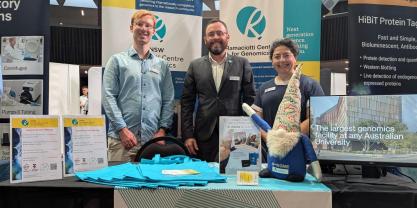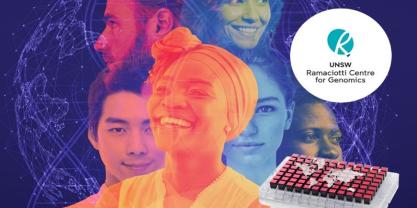Meet our new Director

We are excited to introduce Martin Smith, the new Director of the Ramaciotti Centre for Genomics, who joined us four months ago. Below, he shares insights into his journey, initial impressions, and vision for the future of the Centre.

Can you share a bit about your background and experience in genomics research?
I have been fascinated with biology from a young age and developed a particular interest in virology after reading Darwin’s Radio by Greg Bear. This prompted me to enrol in a microbiology & immunology major as an undergrad. However, I found the much-anticipated virology lectures to be underwhelming, which muffled my infatuation with the topic. I decided to change academic gears and foster my interest in programming by enrolling in a Master’s degree of research in bioinformatics. This led me to Quebec City, where I discovered genomics and gained a deep appreciation for this field of research (also mastering my snow shovelling skills).
This passion brought me to Brisbane, where I sharpened my bioinformatics skills and applied them to deeper genomic datasets, namely mining evolutionary data from multiple genome alignments. I was privileged to witness the rise of deep sequencing at the Institute for Molecular Biosciences, where one of the world’s first fleets of next generation sequencing machines were installed. I distinctly recall feeling sympathy for the “poor bioinformaticians who have to process millions of sequences”, naively (or conscientiously) ignoring that this was the fate of most bioinformaticians for the next 2 decades.
I have since been swimming in .fastq files, initially as a consumer as a postdoctoral research officer in neuroscience at the Garvan Institute, then as a developer and service provider at the Kinghorn Centre for Clincial Genomics, generating data from all kingdoms of life, while harnessing my bioinformatics and molecular biology expertise to push the boundaries of what is possible in genomics. I found real-time single-molecule sequencing to be quite fascinating and have devoted significant efforts in exploring the utility of nanopore sequencing.
Appreciating the potential for genomic technologies to improve health outcomes and my frustration at the delays in implementing these prospective benefits brought me back to Canada, where I learned about the challenges and benefits of implementing rapid genomic testing in a clinical setting. This is a fundamental and translational research area I am eager to pursue further at UNSW.
How have your first four months as the Director been, and what are your initial thoughts?
It’s been a whirlwind of excitement, networking, and information absorption. This opportunity is nothing short of my dream job and it has surpassed my expectations to date. Although there is lots on the plate in a fast-moving discipline, I am highly impressed by the organization of the Centre and our Team’s rigorous efforts to ensure the consistent delivery of data and services of the highest quality. Working with such a diverse and devoted team of genomics experts is very inspiring and motivating. The local research ecosystem is also highly impressive; there is enormous potential for genomics in research, education, medicine, and industry in Randwick, notwithstanding the multiple state and national initiatives.
Can you share some accomplishments or projects you've tackled during your time as Director?
Successfully transplanting our home and family of four across the globe is perhaps my most impactful accomplishment so far! Reviewing the Centre’s operations and acquiring knowledge on the multitude of projects and initiatives underway at UNSW and in the broader Australian genomics community has been a principal focus of mine so far. Improving and expanding our bioinformatics capabilities is also a high-priority agenda item.
What recent advancements in genomics excite you the most?
The co-integration of multiple omics technologies into clinical research, the generation of telomere-to-telomere genomes, improvements in direct RNA sequencing, the increased accessibility of whole genome sequencing for population-scale studies, and (in particular) the inclusion of Indigenous communities in genomics initiatives are exciting advancements that I am eager to support.
Any noteworthy advancements in genomics technology that you've introduced or plan to?
I have integrated a PromethION sequencer to expand our nanopore sequencing capacity. I would like to leverage some aspects of this technology in combination with artificial intelligence tools to deliver new clinical decision support solutions to improve the molecular diagnosis of complex diseases.
I’m also planning to increase our next-generation sequencing capacity in line with bespoke computational and analytical workflows to fuel and sustain local demand.
Can you give us a glimpse into your vision for Ramaciotti’s future?
I’d like to expand the Centre’s mission to include education and innovation in addition to our existing expertise. Increased bioinformatics support, training workshops and the implementation/evaluation of new technologies are on the agenda.
The Ramaciotti Centre is uniquely positioned in Oceania, benefitting from a diverse academic ecosystem and aligned centrally with strategic UNSW initiatives including the RNA Institute, the Cellular Genomics Futures Institute and the AI Institute. I intend to work closely with these stakeholders to foster innovative genomics research and impactful outcomes for society.
I also envision that the Centre will be a central component of the Randwick Health and Innovation Precinct, working closely with clinicians and pathologists to deliver multi-omics data of the highest quality on demand. My dream is to collaboratively develop and implement a real-time genomics platform to aid clinicians, improve health outcomes in patients, support medical research, and increase the efficiency of public health care.



